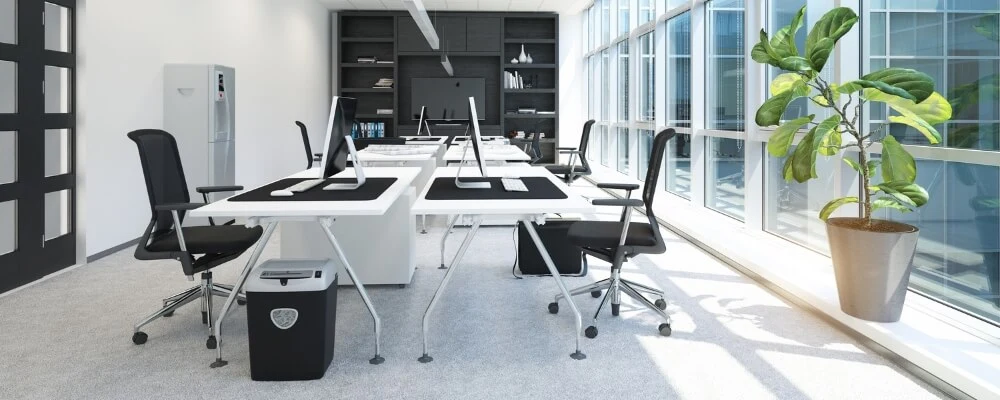In the bustling ecosystem of any office, safety often goes beyond the simple adage of ‘watch your step’. As we navigate a dynamic blend of traditional work environments and digital spaces, understanding the diverse aspects of office safety becomes not just a necessity but a responsibility for every individual. From the tangible threats of chemical mishandling and fire hazards to the intangible realms of cybersecurity and mental well-being, the modern workplace faces challenges that require our collective attention.
This comprehensive guide will delve into 10 crucial office safety topics for everyone. Whether you’re an employer, an employee, or someone stepping into the corporate world for the first time, this is a must-read to ensure a secure, healthy, and productive work environment for all.
10 Crucial Office Safety Topics To Discuss For Everyone’s Safety
Office safety is of utmost importance. Below are 10 crucial topics to discuss to ensure a safe working environment for everyone:

1. Emergency Preparedness
In any workplace, being prepared for emergencies is paramount. This involves clearly understanding evacuation routes, which should be marked, unobstructed, and well-known by all employees. Familiarity with these routes can greatly reduce panic and chaos during unexpected situations. Muster points, designated areas where employees gather after evacuating, are equally crucial. They ensure everyone is accounted for and safe.
Regular fire and emergency drills are not just a formality. They reinforce these routes and points, ensuring that employees know exactly where to go and what to do in the heat of the moment. Additionally, every employee should be aware of the locations of emergency exits and fire extinguishers. Knowing where these are and how to use them can be the difference between a minor incident and a major catastrophe.
2. Ergonomics
A well-set-up workstation is not just about comfort; it’s about health. Ergonomics, the study of people’s efficiency in their working environment, suggests that poor workstation setup can lead to chronic injuries over time, including carpal tunnel syndrome or back issues. Key components include an ergonomically designed chair that supports the natural curve of the spine and a desk at the right height to prevent strain on the neck and eyes.
Beyond furniture, maintaining correct posture cannot be stressed enough. Slouching or sitting improperly can lead to long-term ailments. Moreover, sitting continuously for extended periods can strain the body. Regular breaks can alleviate this strain and boost overall productivity, even if it’s just a short walk or stretch.

3. Slips, Trips, and Falls
One of the most common office hazards is the risk of slips, trips, and falls. Something as innocuous as a wet floor or an open drawer can result in severe injuries. Wet floors, whether from cleaning or spills, should be promptly signposted and addressed. Similarly, cluttered walkways can be a trip hazard and impede safe evacuation during emergencies. Items like loose carpets or mats need to be secured or removed to ensure they don’t become obstacles.
Moreover, the principle of good housekeeping cannot be overemphasized. A tidy workspace reduces risks and improves overall efficiency. Encouraging employees to report potential hazards immediately ensures timely intervention and prevention of possible accidents.
4. Electrical Safety
Every office is filled with a maze of electrical devices and cords. However, these modern conveniences can become hazards if not managed properly. Overloading power outlets can cause electrical failures or even fires. Regular inspection of electrical cords is crucial; frayed or damaged cords can be shock hazards and should be replaced immediately.
Everyone knows water and electricity don’t mix, but it’s easy to forget. Keeping liquids away from electrical equipment prevents accidental spills, which can lead to both equipment damage and personal injury. Handling electrical devices carefully is essential, ensuring they are stored in safe places that won’t be knocked over or damaged.
5. Fire Safety
Fire is a potent and destructive force, and preventing office fires requires vigilance on multiple fronts. First, the safe storage and disposal of flammable materials are non-negotiable. Improperly stored materials can easily ignite a minor incident into a major fire. Electrical appliances, a staple in any office, must be used correctly.
Misusing these devices or using faulty appliances can result in overheating, sparking, and potentially fires. Equally important is the awareness of office safety installations. Blocking sprinklers, fire alarms, or fire exits can severely hamper efforts to control fires and evacuate people. All employees must be educated about these installations, ensuring they remain unobstructed and functional.
6. Chemical Safety
In many workplaces, employees come into contact with cleaning supplies and other chemicals. Ensuring their safety requires a comprehensive understanding and adherence to proper storage, use, and disposal practices. Chemicals should always be stored consistent with their labeling and in designated storage areas, which are typically cool, dry, and well-ventilated. Beyond storage, employees should be educated about the appropriate use of each chemical, including the use of personal protective equipment if necessary.
A chemical mishap can be detrimental, affecting health or causing a reactive incident. Proper disposal is equally essential, as disposing of chemicals down the drain or in regular trash can harm the environment or even result in dangerous reactions. Integral to all these practices is the Material Safety Data Sheets (MSDS). These sheets provide detailed information on the properties of each chemical, potential hazards, handling and storage instructions, and first aid measures. Employees who work with or around chemicals should be familiar with and have access to the MSDS for each substance in their vicinity.

7. Physical Security
Physical security is the cornerstone of a safe working environment. Every office should prioritize securing its premises, which begins with controlled access. Limiting entrance to authorized personnel ensures that potential threats or disruptions are kept at bay. Security systems, identification badges, or reception-controlled access can all serve this purpose. Employees play a pivotal role in maintaining this security by being vigilant and reporting any suspicious activities or unrecognized individuals.
Despite best efforts, there might be situations where an intruder gains access or poses an active threat. In such cases, a predefined protocol should be in place, which employees are trained in, ensuring that they know the steps to take, whether it’s to shelter in place, evacuate, or alert authorities.
8. Mental Health and Stress
The importance of mental well-being in the workplace cannot be overstated. A mentally healthy workforce is not just happier but also more productive. Recognizing signs of stress among colleagues or oneself is the first step toward addressing them. Prolonged stress can lead to burnout, decreased productivity, and severe mental health conditions.
Companies should actively offer resources for assistance, be it counseling services, helplines, or mental health days. Creating a culture where discussions about mental health are encouraged and not stigmatized is crucial. This supportive environment ensures employees feel valued, understood, and, most importantly, not alone in their struggles.
9. First Aid and Health
No matter how minor, accidents are unpredictable and can occur in any office setting. Having first aid kits readily available and accessible is a primary safety measure. However, their mere presence isn’t enough; employees should be aware of their locations and, ideally, trained in using their content. Beyond immediate treatment, reporting and documenting any injuries are paramount. This not only aids in understanding the cause and preventing future incidents but also ensures the injured party receives necessary continued care.
Further, a basic understanding of common medical emergencies, like heart attacks, strokes, or choking, can be lifesaving. Training sessions or workshops teaching these first aid procedures can be invaluable.

10. Cybersecurity
Cybersecurity is as crucial as any other safety measure in today’s digital age. Cyber threats can lead to significant financial, reputational, or operational damage. Safe online practices begin with the basics: Employees should be educated on identifying and avoiding potential threats, such as phishing scams that attempt to steal sensitive information. A strong, unique password for each online service or software is essential, and the use of password managers can make this more manageable.
Any suspicious emails, especially those asking for personal information or urging immediate action, should be treated cautiously. Reporting these or any unusual software behaviors to the IT department ensures that potential threats are addressed promptly and reduces the risk of widespread impact.
Conclusion
In the multifaceted landscape of the modern workplace, being armed with knowledge of safety protocols is not just a recommendation—it’s imperative. The ten crucial office safety topics we’ve explored highlight the interconnectedness of our physical, digital, and mental spaces. Each facet, from ergonomics to cybersecurity, is pivotal in forging a productive and safe environment.
By fostering awareness, encouraging open dialogue, and implementing robust safety measures, we can collectively create workplaces prioritizing every individual’s well-being. As the adage goes, “Safety first is safety always.” Let’s ensure we carry this mantra forward, championing a culture of care, vigilance, and shared responsibility in our daily professional lives.

